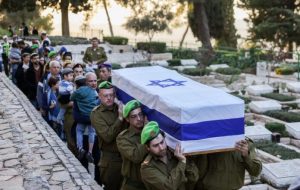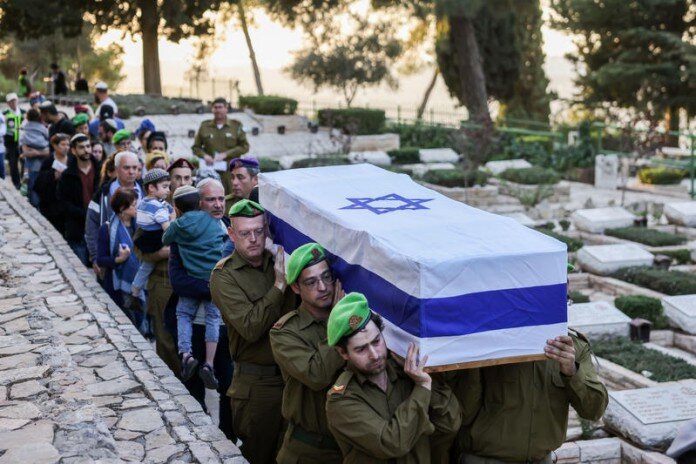955 Israeli casualties on the Lebanese border
TEHRAN- The Lebanese Hezbollah resistance fighters inflicted around 1,000 casualties on the Israeli army in battles on the border with occupied Palestine in October. According to an extensive report issued by Hezbollah’s Operations Room over 95 Israeli soldiers and officers have been killed and 900 injured. The resistance noted that this toll does not include


TEHRAN- The Lebanese Hezbollah resistance fighters inflicted around 1,000 casualties on the Israeli army in battles on the border with occupied Palestine in October.
According to an extensive report issued by Hezbollah’s Operations Room over 95 Israeli soldiers and officers have been killed and 900 injured.
The resistance noted that this toll does not include the Israeli enemy’s losses in the “military bases, barracks, settlements as well as occupied cities” struck by Hezbollah’s extensive rocket barrages.
The report highlights that recent days have seen repeated attempts by the invading army to advance in the front-line southern villages from five directions, which Hezbollah continues to repel.
This is despite the fact that the infantry enjoys “heavy air and artillery cover”.
The Lebanese resistance says the infiltration attempts include an area extending from Naqoura in the west to Marwahin in the east.
The second area of infiltration extends from Ramya in the west to Rmeish in the east.
The third point where Israeli infantry has been trying to invade southern Lebanon is from Bleida in the south to Houla in the north.
“The enemy maintains control by fire over the eastern outskirts of Bleida, Mais al-Jabal, and Houla. However, no new advancement attempts have been made following fierce battles in Houla last week, which inflicted significant losses on the advancing forces.”
The fourth infiltration attempt has been from Marqaba in the south to the occupied Lebanese village of Ghajar in the northeast.
And the fifth point on the Lebanese border is from Ghajar to the occupied Shebaa Farms.
Here, Israeli occupation forces (IOF) have made multiple attempts over the past weeks to take control of the town of Khiam.
Heavy fighting has been widely reported to have taken place in this town over the past several days.
It is perhaps the most strategic region of southern Lebanon should the IOF take full control of the town because of its geographically high terrain.
Capturing Khiam would allow the IOF strategic access to the occupied Golan as well as the Kafr Shuba hills.
Tel Aviv has deployed Division 210, also known as Bashan or Utzbat HaBashan, to occupy Khiam.
On Thursday, in the direct clashes that took place with Hezbollah east of the town, the Israeli division 211, used smoke defenses to cover its movements.
Nevertheless, the Lebanese resistance engaged in zero-distance clashes with the IOF inside the eastern neighborhoods near the Khiam prison.
The prison, which the IOF is trying to occupy, is located on a high hill inside the town that also overlooks northern Israel.
According to reporters in southern Lebanon, Hezbollah inflicted heavy losses on the IOF, which collected its dead and wounded soldiers near Khiam prison and retreated after the failure of its attack.
Hezbollah: “42 Merkava tanks, 4 military bulldozers, 2 Humvees, 1 armored vehicle and 1 APC destroyed”The statement by Hezbollah’s Operations Room pointed out that its “fighters continue to confront repeated enemy advancements toward the southern and southeastern neighborhoods of Khiam with various rocket and artillery types, achieving confirmed hits.”
Reports on Friday indicate that fighting in the areas around Khiam is now witnessing a decline in intensity after the failure of the IOF to enter.
However, the IOF is reported to have dropped phosphorus bombs despite the use of these munitions violating international law.
“Islamic Resistance fighters continue to repel the Israeli aggression on Lebanon, inflicting heavy losses on the enemy’s forces and equipment across confrontation axes from the front lines to their positions deep within occupied Palestine,” Hezbollah said in its report.
Elsewhere, Hezbollah’s report also pointed out that “supply lines to the frontline and areas of engagement (with the IOF) have remained unbroken since the beginning of the aggression on Lebanon. Frontlines are still supplied with necessary weapons and personnel according to pre-prepared plans.”
In another part of the report Hezbollah said that “despite the intelligence blockade imposed by the enemy over the southern skies, the resistance fighters continue to prepare, load, and launch hundreds of rocket salvos towards enemy troop positions deep within the entity on a daily, continuous, and round-the-clock basis. This is confirmed by footage released by military media, and the enemy has failed to thwart any launch operation from Lebanese territory.”
According to analysts, the resistance fighters have forced the IOF not to use military vehicles in their attacks for fear of anti-tank missiles.
Hebrew media has also spoken of the difficulty of intercepting and monitoring Hezbollah drones, which has caused a great headache for the Israeli Air Force.
Furthermore, according to Israeli media, Hezbollah’s rocket fire cannot be completely stopped, and no one in the Israeli army boasted about that possibility; they only spoke about reducing it.
Meanwhile, after several days of calm, southern Beirut’s Dahiyeh suburbs have come under heavy Israeli bombardment.
Hezbollah military media published a video with the warning: “We will make Haifa like Kiryat Shmona and Metula”.
The Lebanese resistance had previously vowed to strike Haifa for every attack on the Dahiyeh and Tel Aviv for attacks on Beirut.
Kiryat Shmona and Metula have been almost deserted by its settlers amid Hezbollah rocket fire.
